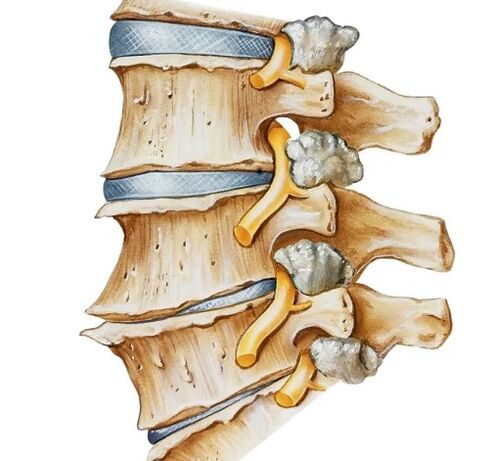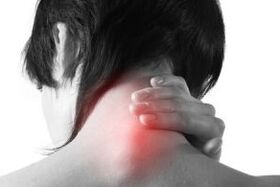UpOsteochondrosis and treatment of cervical spine symptomsThey will be different from the type of cervical spine deformity, due to their long physical, inflammatory or mental effect.

The disease is often chronic, manifested by many clinical symptoms caused by weakening of nerve roots and blood vessels that pass through the vertebrate. Their contraction is due to the wear or deformation of intervertebral discs (reduced height, loss of elasticity, deformity of the fiber rim or decomposition). Cervical osteochondrosis is a normal disease that occurs at any age after 20 years.
The cause of the pathology is in the destructive changes of the spine. First of all, the intervertebral disc changes occur: their elasticity, strength and height, their fiber rim is deformed, prosthesis (initial stage of intervertebral hernia) and hernia appear. All of these changes cause bones to grow on the vertebrates (osteophytes), lead to movement, and later - loss of cervical spine. Since the flexible "case of the case" of the spine to the spinal cord, the destructive changes of the intervertebral discs and the loss of the flexibility of the spine are harmful to the nerve and vascular structures. They are subject to weakening, movement, which disrupts cerebral circulation and not only the cervical and shoulder zone, but also the internal organs, the lower extremities.
The older the patient is, the more intervertebral discs are replaced by age -related muscle weakening, long loads of spine, injuries, physical activity, inappropriate postures, stressful situations and increased neck tension, shoulder girdle, inflammatory diseases of the spine, and so on. Sh.

Due to its anatomical structure, the cervical spine is more prone to pathology, as its vertebrates are most mobile and very closely located in relation to each other. In addition, cervical vertebrates have weak muscle protection. Most often, degenerative changes develop in the most mobile 5. 6, 7 cervical spine intervertebral discs.
What are the symptoms of cervical osteochondrosis
The diversity and inconsistency of symptoms
Osteochondrosis and treatment of cervical spine symptomsIt should be considered as a comprehensive and degeneration type and gravity of the intervertebral discs. Signs of cervical osteochondrosis are varied and contradictory as they depend on localization and strength, the process of intervertebral disc deformation, nerve roots and blood vessels, as well as their blood.
Thus, patients' complaints are often not directed to a neurologist, but for other specialists: a cardiologist, therapist, otolaryngologist, optometerist, rheumatologist, etc. Sh. At the same time, a neuropathologist can name cervical osteochondrosis diagnosis based on the results of the brain and spine MRI, the brain, electricity, and so on. Sh.
Three sets of a decreased function of the nervous system
Experienced specialists know about thirty different variants of a combination of cervical osteochondrosis. It will not be possible to describe all signs of manifestations of this common disease, so let's thinkThree complexesThe main symptoms that characterize certain impaired functions of the central nervous system.
The first complex of the main symptoms extends to the decreased functions of the peripheral section of the nervous system. This section is represented by nerves and other elements that leave the brain and spinal cord and are divided into somatic and autonomic systems.
In short, the first complex of symptoms of cervical osteochondrosis is represented as a different localization of pain. This does not mean that the signs are only painful, often the pains combine other impaired functions of the body. Basically - it is a permanent or periodic pain in the neck, the appearance of the patient with hypothermia, prolonged stress or uncomfortable posture, losing weight, drastic turning.
Pains aching, shooting or shocking. Their localization depends on the tension of certain muscles associated with specific roots of the nerves that are reddish by the spine. Thus, the pain can spread to the neck, spark, shoulder, one or both hands, radiation in the chest - in the area of the heart, liver. In addition, there are complaints in the vertebrates of the cervical region when the head moves, as well as the strength of the head rotation movements.
At the onset of the disease, neck muscle pain and spasms force the patient to be prone to head in posture. Combustion pains may appear between the shoulder blades if the vegetative cervical formation is compressed and their blood supply is disordered. Such pains usually increase with physical and emotional stress.
Often swelling of the hands, pale and cooling, their numbness, heartbeat, pain in the heart, narrowing or enlargement of students, etc. Sh. Symptoms of shoulder dystrophic change may occur due to the decreased shoulder and spatular region. Patients complain of pain, prevent it and prevent the side, with the firmness of the shoulder joint.
The second complex of cervical osteochondrosis symptoms occurs due to impaired spinal cord function and is manifested by engine disorders.
Spinal cord function disorders occur due to its compression, disk or damage as a result of hard disks and growth (osteophytes) (osteophytes). Depending on the mechanism of exposure to the spinal cord, the following complex of motor disorders is marked: the strength of the back and cervical muscles, the weakness of the arm and the legs, the increased tone of the leg muscles, and the reduced tone and weight loss; Loss of temperature and pain sensitivity; Severe fatigue of the feet, impaired coordination.
The third set of symptoms is characterized by blood supply to the brain and the pathology of the cranial nerves, which occurs due to deformation in the cervical spine. Symptoms of vascular pathology appear.
Symptoms of vascular disorders:
- Neurotic conditions (irritation, longing, anxiety, fatigue, sleep disorders);
- Bleaching; Headache and dizziness; Nausea and vomiting;
- Noise and bell in the ears, hearing loss;
- Visual disorders (eye -catching, fog, flickering points, visual impairment);
- Great mining syndrome (sore throat, sense of foreign object, dryness, difficulty swallowing).
Symptoms of cervical osteochondrosis are not unambiguous and should be considered in the complex and dependent on the pathological processes of the spine.
Only a qualified specialist can cope with the clinical manifestations of this disease, make a proper diagnosis, and determine the correct treatment for the causes of the disorders.
How to treat this disease
Osteochondrosis of the cervical spine and the treatment of the patient's condition, the severity of the disease, the nature of the cervical spine.
In acute periods, hospitalization and drug treatment may be necessary. Usually used analgesics, novocaine muscle blockade, muscle calmers that relieve muscle spasms; Chondroprotectors for cartilage tissue nutrition; Sedative medications that calm the nervous system, B vitamins, neuromuscular conduction. Treatment of cervical spine osteochondrosis is always long and it should be difficult.
During remission, when there are no severe symptoms, physiotherapy methods (electrophoresis, ultrasound, etc. ), therapeutic physical education, massage, as well as unusual procedures, such as acupuncture, are definitely established.

Many conservative methods of treatment for osteochondrosis are known, which can stop the disease progression. However, each patient needs an individual course of treatment at the stage of the disease, taking into account the characteristics of the body, sex and age. The purpose of cervical osteochondrosis is:
- Eliminate pain and swelling at the site of inflammation.
- Neck tense muscles rest.
- Locked nerve roots.
- Increase blood circulation.
- Activating metabolism.
- Improving the energy of intervertebral discs.
Targeted complex treatment prevents the formation of protrus and intervertebral hernia.
Symptoms and treatment for osteochondrosis and treatment do not begin, and severe complications of the disease should begin with timely treatment.

























